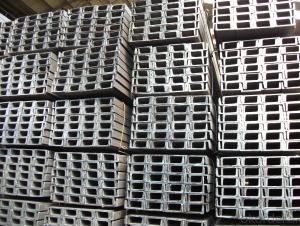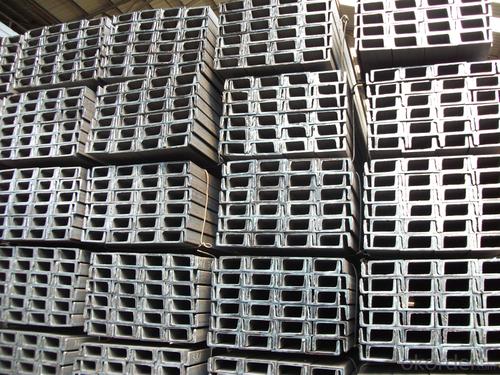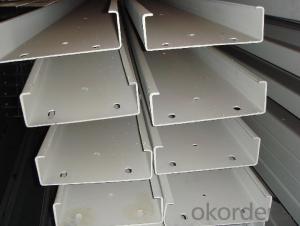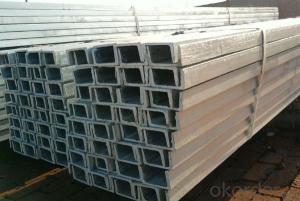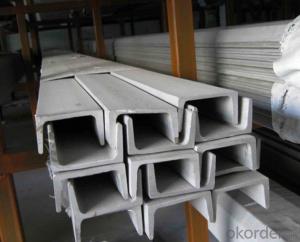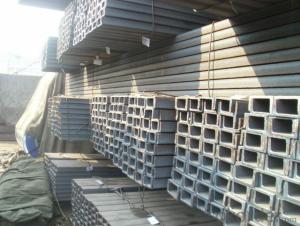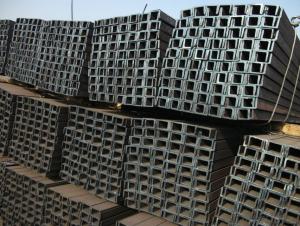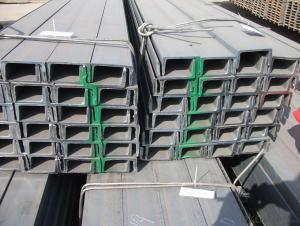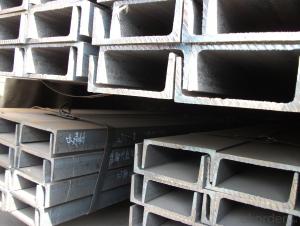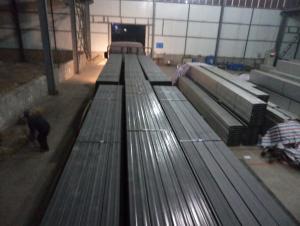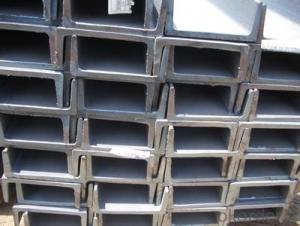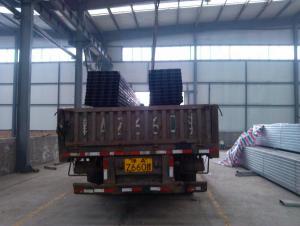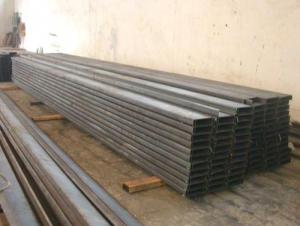HR U Channel Steel with JIS Standard Made in China
- Loading Port:
- Tianjin
- Payment Terms:
- TT or LC
- Min Order Qty:
- 30 m.t.
- Supply Capability:
- 40000 m.t./month
OKorder Service Pledge
OKorder Financial Service
You Might Also Like
Product Description:
OKorder is offering HR U Channel Steel with JIS Standard Made in China at great prices with worldwide shipping. Our supplier is a world-class manufacturer of steel, with our products utilized the world over. OKorder annually supplies products to European, North American and Asian markets. We provide quotations within 24 hours of receiving an inquiry and guarantee competitive prices.
Product Applications:
HR U Channel Steel with JIS Standard Made in China are ideal for structural applications and are widely used in the construction of buildings and bridges, and the manufacturing, petrochemical, and transportation industries.
Product Advantages:
OKorder's HR U Channel Steel with JIS Standard Made in China are durable, strong, and resist corrosion.
Main Product Features:
· Premium quality
· Prompt delivery & seaworthy packing (30 days after receiving deposit)
· Corrosion resistance
· Can be recycled and reused
· Mill test certification
· Professional Service
· Competitive pricing
Packaging & Delivery:
Packaging Detail: products are packed in bundle and then shipped by container or bulk vessel, deformed bar is usually naked strapping delivery, when storing, please pay attention to moisture proof. The performance of rust will produce adverse effect.
Each bundle weight: 2-3MT, or as required
Payment term: TT or L/C
Delivery Detail: within 45 days after received advanced payment or LC.
Label: to be specified by customer, generally, each bundle has 1-2 labels
Trade terms: FOB, CFR, CIF
FAQ:
Q1: Why buy Materials & Equipment from OKorder.com?
A1: All products offered byOKorder.com are carefully selected from China's most reliable manufacturing enterprises. Through its ISO certifications, OKorder.com adheres to the highest standards and a commitment to supply chain safety and customer satisfaction.
Q2: How do we guarantee the quality of our products?
A2: We have established an advanced quality management system which conducts strict quality tests at every step, from raw materials to the final product. At the same time, we provide extensive follow-up service assurances as required.
Q3: How soon can we receive the product after purchase?
A3: Within three days of placing an order, we will begin production. The specific shipping date is dependent upon international and government factors, but is typically 7 to 10 workdays.
Images:
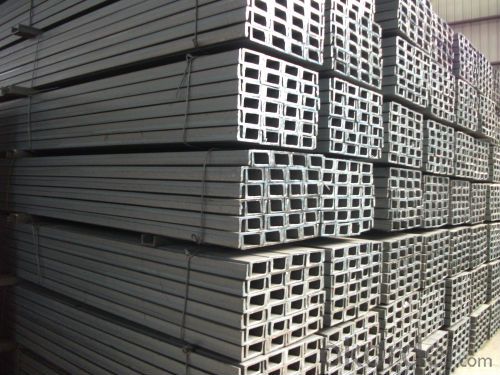
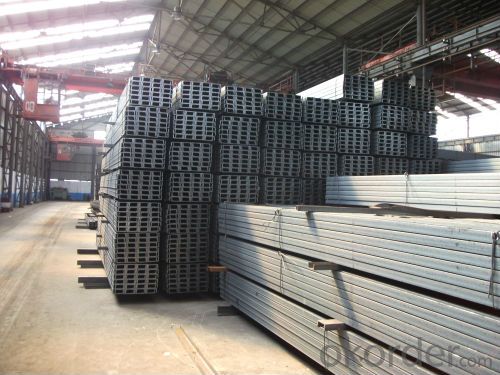
- Q: What are the different methods of cutting steel channels?
- There are several different methods of cutting steel channels, including using saws, plasma cutters, waterjet cutting machines, and laser cutting technology. Each method has its own advantages and disadvantages, depending on factors such as the desired precision, speed, and cost.
- Q: What are the common material testing procedures for steel channels?
- Steel channels undergo a range of tests to assess their quality and properties. These tests include: 1. Tensile Test: This test determines the tensile strength, yield strength, and elongation of the steel channels. The sample is gradually loaded until it breaks, and the stress-strain relationship is measured. 2. Hardness Test: The hardness of the steel channels is measured using methods like Rockwell, Brinell, or Vickers tests. It indicates the material's resistance to indentation or scratching. 3. Charpy Impact Test: This test evaluates the toughness and impact resistance of the steel channels. A notched sample undergoes a high-velocity impact, and the absorbed energy is measured. This helps assess the material's ability to withstand sudden shocks. 4. Bend Test: This test assesses the ductility and deformation behavior of the steel channels. A sample is bent to a specific angle without breaking, and the extent of bending is examined to ensure it meets required standards. 5. Chemical Analysis: Steel channels undergo chemical analysis to determine their composition, including the percentage of carbon, manganese, silicon, sulfur, phosphorus, and other alloying elements. This ensures the material meets specific requirements. 6. Ultrasonic Testing: Ultrasonic waves are used to detect any internal flaws or defects in the steel channels. This non-destructive method helps identify cracks, voids, or inclusions that may compromise the material's quality. 7. Dimensional Inspection: The dimensions and tolerances of the steel channels are measured to ensure they meet required specifications. This includes checking the width, height, thickness, and overall geometry of the channels. These testing procedures are vital in ensuring the quality, strength, and performance of steel channels, making them suitable for various industries such as construction, manufacturing, and infrastructure.
- Q: How to judge whether the joint of steel structure is rigid or hinged, as shown below, the steel beam and steel column are all channel steel and welded through weld joint.
- A hinge: as the name suggests, the theory is completely unable to bear joint moment, and generally cannot be used for splicing component connection; hinged joints are usually only used for connecting end members, such as the end of the column and beam connections.
- Q: Can steel channels be used for fencing purposes?
- Yes, steel channels can be used for fencing purposes. Steel channels are versatile and strong, making them an excellent choice for fencing applications. They can be used to create a sturdy and durable fence structure that can withstand various weather conditions and provide security. Steel channels can be easily customized to fit different fencing designs and sizes, and they can be combined with other materials like wire mesh or panels to create a more secure and visually appealing fence. Additionally, steel channels are resistant to corrosion, which makes them a long-lasting option for fencing projects.
- Q: What are the lengths of the channel factory?
- Thickness is: 12 ~ 50mm, width is: 1800 ~ 2600mm, length is: 6000 ~ 12000mm
- Q: Are steel channels suitable for supporting overhead equipment or structures?
- Indeed, steel channels prove to be a fitting choice when it comes to supporting overhead equipment or structures. Their strength and durability make them a common choice in construction and engineering endeavors. By offering a secure and dependable support system, steel channels ensure safety and stability. These channels are specifically designed to bear heavy loads, making them an ideal option for supporting equipment or structures that demand a robust and steadfast foundation. Moreover, steel channels can be tailored to meet precise project specifications, encompassing size, shape, and length, further amplifying their appropriateness in supporting overhead equipment or structures.
- Q: How do steel channels contribute to the energy efficiency of a building?
- Steel channels contribute to the energy efficiency of a building in several ways. Firstly, steel channels can be used to create structural frames and support systems, which help distribute the weight of the building evenly and efficiently. This allows for more open and flexible floor plans, reducing the need for additional support columns and walls. By minimizing the use of materials, steel channels help optimize the use of space and reduce the overall energy consumption required for construction. Additionally, steel channels are known for their high strength-to-weight ratio, which means they can support heavy loads while having a relatively low weight themselves. This property allows for the construction of taller and larger buildings, maximizing the usable space without compromising on structural integrity. As a result, more occupants can be accommodated within a smaller footprint, leading to greater energy efficiency in terms of land use. Steel channels also contribute to energy efficiency through their durability and longevity. Steel is a highly durable material that can withstand extreme weather conditions, resist corrosion, and remain structurally sound over time. This reduces the need for frequent repairs and replacements, resulting in lower maintenance costs and less energy consumption associated with building maintenance. Furthermore, steel channels can be used as part of an efficient insulation system. Insulated steel channels can be integrated into the building envelope, providing a thermal barrier that helps regulate indoor temperature. This insulation reduces the reliance on heating and cooling systems, resulting in lower energy consumption and improved energy efficiency. Lastly, steel channels are often made from recycled steel, which has a significantly lower carbon footprint compared to the production of virgin steel. By using recycled materials, the environmental impact of the building's construction is reduced, contributing to overall energy efficiency. In conclusion, steel channels contribute to the energy efficiency of a building by enabling efficient structural designs, optimizing space utilization, providing durability and longevity, supporting insulation systems, and utilizing recycled materials. These factors collectively reduce energy consumption, improve building performance, and contribute to a more sustainable and environmentally friendly construction industry.
- Q: What are the different industry standards for steel channels?
- Steel channels are subject to various industry standards that aim to maintain consistency and quality in their manufacturing and usage. Notable standards for steel channels include: 1. American Standard Channels (C): These channels, recognized by the American Iron and Steel Institute (AISI), are widely employed in North America. ASTM A6/A6M specifies the dimensions, properties, and tolerances for American Standard Channels. 2. European Standard Channels (UPN): These channels, defined by the European Committee for Standardization (CEN), are prevalent in Europe. EN 10365 outlines the dimensions, properties, and tolerances for European Standard Channels. 3. British Standard Channels (BS): These channels, established by the British Standards Institution (BSI), are commonly used in the United Kingdom. BS 4-1 specifies the dimensions, properties, and tolerances for British Standard Channels. 4. Japanese Standard Channels (JIS): These channels, defined by the Japanese Industrial Standards (JIS), see extensive use in Japan and other Asian countries. JIS G 3192 outlines the dimensions, properties, and tolerances for Japanese Standard Channels. 5. Australian/New Zealand Standard Channels (AS/NZS): These channels, defined by Standards Australia and Standards New Zealand, are frequently employed in Australia and New Zealand. AS/NZS 3679.1 specifies the dimensions, properties, and tolerances for Australian/New Zealand Standard Channels. It is important to recognize that these standards may vary slightly in terms of dimensional tolerances, chemical composition, mechanical properties, and designations. Consequently, comprehending and adhering to the appropriate industry standard is essential to ensure compatibility and compliance with the specific requirements of a given project or application involving steel channels.
- Q: What is the weight per meter of different steel channel sizes?
- The weight per meter of different sizes of steel channels can fluctuate based on the distinct dimensions and thickness of the channels. When assessing steel channels, their height, width, and thickness are typically measured. To determine the weight per meter, you will need knowledge of the dimensions and density of the particular steel type being employed. The weight per meter can be determined by multiplying the cross-sectional area of the channel by the steel's density. For instance, let's presume we possess a steel channel with dimensions of 100mm (height) x 50mm (width) x 6mm (thickness), and the steel's density is 7.85 grams per cubic centimeter (g/cm³). Initially, let's convert the dimensions to meters: Height = 100mm = 0.1m Width = 50mm = 0.05m Thickness = 6mm = 0.006m Subsequently, compute the cross-sectional area: Area = Height x Width = 0.1m x 0.05m = 0.005 square meters (m²) Lastly, ascertain the weight per meter: Weight per meter = Area x Thickness x Density = 0.005m² x 0.006m x 7.85g/cm³ = 0.0002355 kg/m Therefore, for a steel channel with dimensions of 100mm x 50mm x 6mm, the weight per meter would be around 0.0002355 kg/m. It is crucial to note that this calculation is merely an example, and the weight per meter will fluctuate based on the specific dimensions and density of the steel being utilized.
- Q: How do steel channels contribute to building envelope performance?
- There are several ways in which steel channels contribute to the performance of building envelopes. To begin with, steel channels are commonly used as framing elements in the construction of building envelopes. These channels serve to provide structural support and distribute loads, ensuring that the building remains stable and intact. This is particularly important in regions with strong winds or seismic activity, where the building envelope must be able to withstand external forces. Furthermore, steel channels can be utilized to establish a continuous air barrier within the building envelope. By effectively sealing and insulating the channels, air leakage can be minimized, resulting in reduced energy loss and improved energy efficiency for the building. This is of paramount importance in terms of thermal comfort and the reduction of heating and cooling expenses. Moreover, steel channels can be incorporated into the building envelope as part of a rainscreen system. Rainscreens are designed to manage moisture and prevent water infiltration, while still allowing for proper ventilation. By utilizing steel channels as support for cladding materials, such as metal panels or glass, a protective barrier against the elements can be created. Finally, steel channels offer a great deal of design flexibility and versatility. They can be easily customized and installed in various configurations to meet specific design requirements and aesthetic preferences. This enables architects and designers to create visually appealing building envelopes while still maintaining performance and durability. In summary, steel channels play a vital role in enhancing the performance of building envelopes by providing structural support, establishing air barriers, managing moisture, improving energy efficiency, and offering design flexibility.
Send your message to us
HR U Channel Steel with JIS Standard Made in China
- Loading Port:
- Tianjin
- Payment Terms:
- TT or LC
- Min Order Qty:
- 30 m.t.
- Supply Capability:
- 40000 m.t./month
OKorder Service Pledge
OKorder Financial Service
Similar products
Hot products
Hot Searches
Related keywords
